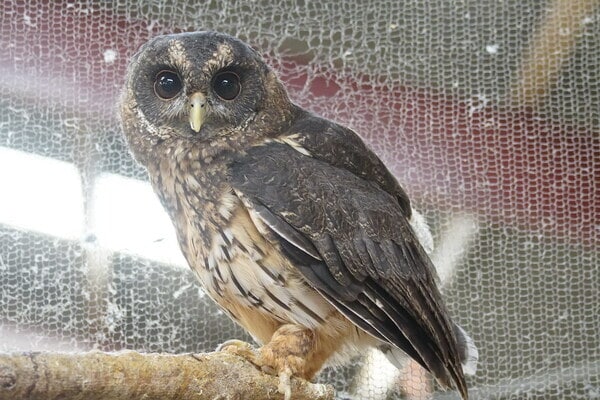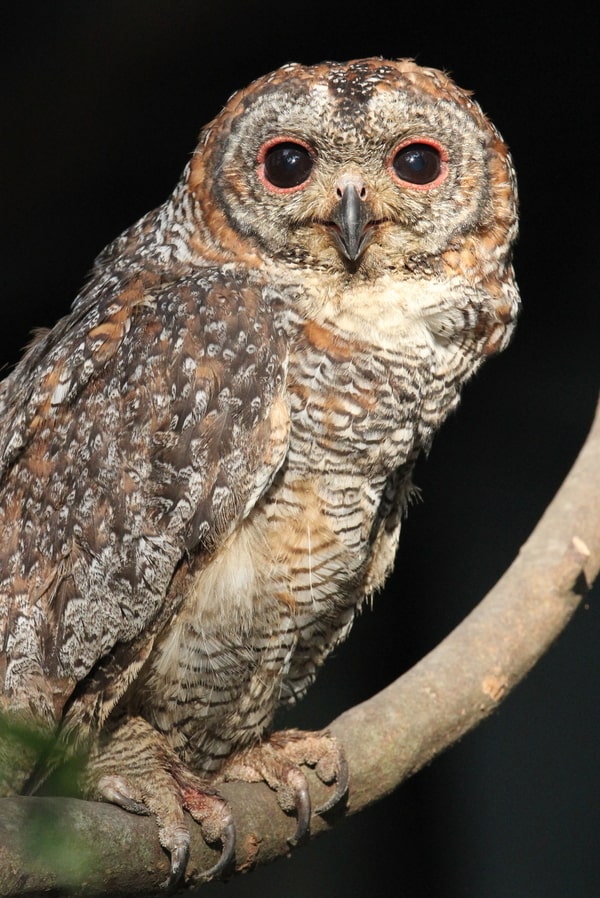Mottled Owls (Ciccaba virgata) are a medium-sized species of owl that inhabit the forests of Central and South America. They are also known by other common names, including the Striped Owl, Hoot Owl, and Mottled Wood Owl.
Physical Characteristics of Mottled Owls:
Mottled Owls range in size from approximately 40-50 cm (16-20 in) in length and have a wingspan of approximately 95-110 cm (37-43 in). They are relatively heavy for their size and can weigh up to 700 g (24.7 oz), making them one of the larger species of owls in their range.
Mottled Owls have brownish-gray plumage that is heavily streaked and mottled with black and white. This coloration provides excellent camouflage, helping them blend into the tree bark and foliage where they roost during the day. Their plumage is also soft and fluffy, which helps to muffle the sound of their flight.
Mottled Owls have large, round heads with prominent ear tufts that are actually made up of feathers rather than actual ears. These ear tufts are used for communication and signaling during courtship and territorial displays. They have large, yellow eyes that are forward-facing, providing excellent depth perception for hunting in low-light conditions. They also have a hooked beak that is sharp and powerful, which is used for tearing and crushing the flesh of their prey.
Mottled Owls have broad, rounded wings that are adapted for silent flight. Their feathers have serrated edges that help to break up the airflow and reduce noise. Their feet are large and powerful, with sharp talons that are used for grasping and killing prey.
Mottled Owls exhibit sexual dimorphism, with males and females having slight differences in size and coloration. Females are slightly larger than males and have more heavily streaked plumage. Males have slightly paler plumage with fewer streaks and are generally more brightly colored.

Behavior and Habitat of Mottled Owls :
Mottled Owls are primarily nocturnal and hunt during the night. They are solitary birds and are usually seen alone or in pairs. They are territorial birds and will defend their territory aggressively against other Mottled Owls or other species of owls. They are also known for their loud, distinctive hooting calls, which they use for communication and territorial displays.
Mottled Owls are opportunistic hunters and will eat a wide variety of prey, including small mammals, birds, reptiles, and insects. They hunt from a perch or while flying, swooping down on their prey with great speed and agility. They also have excellent hearing and can locate prey by sound alone.
Mottled Owls are found in a variety of forest habitats, including tropical rainforests, cloud forests, and dry forests. They prefer dense, mature forests with tall trees for roosting and nesting. They are also found in wooded areas near rivers and streams.
Mottled Owls are cavity nesters, meaning they nest in tree cavities or abandoned nests of other birds. They will also use artificial nest boxes if they are available. They typically lay 2-3 eggs, and both parents help to care for the chicks after they hatch.
Diet of Mottled Owls:
Mottled Owls prey on a variety of small mammals, including rodents, shrews, and bats. They are known to hunt in areas where these mammals are abundant, such as near forest edges or clearings. They use their keen hearing to locate their prey and then swoop down to capture them with their sharp talons.
Mottled Owls also feed on a variety of bird species, including small songbirds, doves, and quails. They are agile hunters and can catch birds in flight or on the ground. They are also known to raid nests and take eggs or chicks as prey.
Mottled Owls also eat a variety of reptiles and amphibians, including lizards, snakes, and frogs. They are known to hunt near bodies of water where these prey items are abundant. They use their keen eyesight to spot these prey items and then swoop down to capture them with their sharp talons.
Mottled Owls also feed on a variety of insects, including beetles, moths, and grasshoppers. They are known to hunt insects in flight, using their keen eyesight to spot them in the dark forest canopy.
Although less common, Mottled Owls have also been known to prey on small fish in streams or rivers. They use their sharp talons to grasp the fish as they fly low over the water.
In conclusion, Mottled Owls have a varied diet that includes small mammals, birds, reptiles, amphibians, insects, and even fish. They are opportunistic predators and will hunt in areas where prey is abundant. Understanding their diet is essential for conservation efforts aimed at protecting these fascinating birds and the ecosystems they inhabit.


Breeding of Mottled Owl:
Mottled Owls form monogamous pair bonds, and courtship usually begins with vocalizations and displays by the male. The male will hoot loudly and display his feathers to attract a mate. Once a pair bond is formed, the male will bring food to the female to establish and maintain the bond.
Mottled Owls typically nest in tree cavities or abandoned nests of other birds, and will occasionally use artificial nest boxes if available. Both parents will help to prepare the nest by adding nesting material such as leaves, moss, and bark. The female will lay 2-3 eggs over a period of several days, and both parents will take turns incubating the eggs for approximately 30 days.
Once the eggs hatch, both parents will care for the chicks. The male will hunt and bring food to the nest, while the female will stay with the chicks to keep them warm and protected. The chicks are born with white down feathers and are completely dependent on their parents for food and care. They will fledge, or leave the nest, after about 35-40 days, but will continue to rely on their parents for food and protection for several more weeks.
Juvenile Mottled Owls have brown feathers with white spots and will continue to rely on their parents for food and protection for several months after fledging. They will eventually become independent and disperse to find their own territories. Mottled Owls reach sexual maturity at 1-2 years of age and can live up to 10 years in the wild.
Conservation Status of Mottled Owl:
One of the major threats to Mottled Owls is habitat loss and fragmentation due to deforestation, agriculture, and urbanization. This can cause a decline in their population as they lose their natural habitat and food sources. The fragmentation of their habitat also isolates populations, which can lead to genetic isolation and a decrease in genetic diversity.
Mottled Owls are sometimes hunted and killed by humans for their meat or feathers. This can have a significant impact on their populations, especially if hunting is done on a large scale. They are also sometimes captured and traded illegally as pets, which can impact their wild populations.
Climate change is also a significant threat to Mottled Owls, as it impacts the availability of their prey and alters their habitat. Changes in temperature and precipitation patterns can also affect their breeding success and overall population dynamics.


Several conservation efforts are underway to protect the Mottled Owl and its habitat. Protected areas have been established to conserve their natural habitat, and forest restoration programs have been implemented to restore degraded forests. Education and awareness programs have also been developed to increase public awareness about the importance of conserving this species and its habitat.
In conclusion, while the Mottled Owl is not considered globally threatened, it is still facing several threats that impact its populations, and its conservation status is a cause for concern. Habitat loss and fragmentation, hunting and poaching, and climate change are significant threats that need to be addressed through conservation efforts. Protecting their habitat and promoting sustainable land-use practices are essential for the long-term survival of these fascinating birds.
How Do They Communicate:
Mottled owls can be found in dry forests that rise to heights as high as 8202 feet (2,500 meters) over sea levels. They. They produce various calls. Whistles and hoots, screeches or purrs, screams hisses, snorts and chitters are some of the vocalizations of the owls that are territorial. Hoot calls from males are more low-pitched than females. The male and female muttled wood owl sound is an antiphonal chorus.
How fast can they fly?
The brown mottled owls that are nocturnal species are incredibly wingspan relative to their body weight and allow the owls to glide at a slow speed. Large species such as the barn owl are able to fly as slow as 2 3 mph (3 km/h) in a quiet glide with only a tiny amount of flapping.
Related Post
- Rufous Owl : A to Z Guide
- What Does A White Owl Mean : A to Z Explanation
- Do Owls Eat Birds : Let’s Understand Why
- Baby Great Horned Owl – A to Z Guide
- Leucistic Owls: Understanding a Rare Genetic Phenomenon
- Do Barred Owls Eat Squirrels : Uncovering the Truth
- Barn Owl Skull: A Look into Nature’s Design
- Barn Owl Feet: Understanding the Unique Anatomy
- Tawny Fish Owl: Facts, Habitat, and Conservation Efforts

